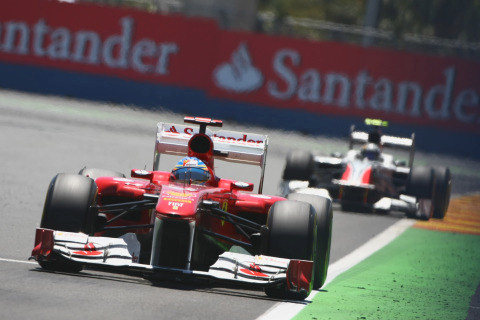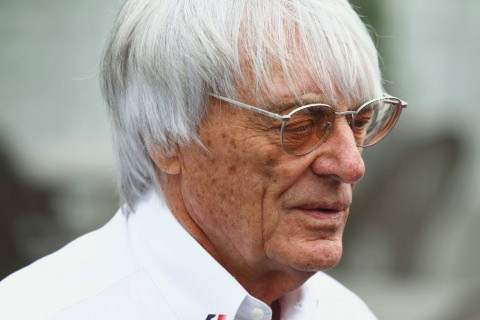The Way It Is/ F1's ongoing power struggle
by Gordon Kirby After all the huffing and puffing over the past year or so about Formula One moving in 2013 to a new 1.6 liter turbo four-cylinder engine the concept has been kiboshed in company with a new, less wing-dependent aero package with more downforce generated from the underwing. Instead F1 will switch to a 1.6 liter turbo V6 in 2014 and apparently continue for the next two years at least with the current chassis and aero rules. The F1 teams also want a 15,000 rpm limit rather than the FIA's original proposal for a 12,000 rpm restriction.
After all the huffing and puffing over the past year or so about Formula One moving in 2013 to a new 1.6 liter turbo four-cylinder engine the concept has been kiboshed in company with a new, less wing-dependent aero package with more downforce generated from the underwing. Instead F1 will switch to a 1.6 liter turbo V6 in 2014 and apparently continue for the next two years at least with the current chassis and aero rules. The F1 teams also want a 15,000 rpm limit rather than the FIA's original proposal for a 12,000 rpm restriction.
Opposition to the four-cylinder engine came from many quarters, including most F1 team owners and Ferrari and Mercedes-Benz in particular. The identities of Ferrari and Mercedes-Benz are wrapped-up in Vee engines, of course, and both manufacturers were adamantly opposed to a move to four cylinders. Other important factors in rejecting the turbo four were the structural nature of an in-line four versus a Vee and fears that a four cylinder turbo just wouldn't produce the kind of exhaust note considered essential to F1.
McLaren's Martin Whitmarsh and others claimed a V6 will provide a much stiffer structure than an in-line four and make for a much better package in general. They also questioned that a turbo four would produce the kind of shrieking sound for which F1 is renowned--a fair question although many people have pointed out that Nelson Piquet won the F1 drivers' world championship in 1983 with a BMW turbo four-banger which made a pretty rude sound as did the turbo Offy Indy engines of the sixties and seventies.
My blog from the Canadian GP about F1's engine rules debate posted on June 17th at Motor Sport's website, www.motorsportmagazine.co.uk, resulted in plenty of energetic discussion among Motor Sport's readers. Many wanted to see the current formula continue, some favored turbo V6s rather than a turbo four and few believe that manufacturers are the key to F1. Similarly, some fans believe racing should adopt the latest in 'green' technology but many agree with Bernie Ecclestone that racing should be a show rather than a 'green' exhibition.

© LAT USA
With both F1 and IndyCar moving to turbo V6s it will be interesting to see what happens to FIA president Jean Todt's push for the 'Global Racing Engine', a four-cylinder turbo that's slowly edging its way into existence, starting with the World Touring Car and World Rally championships. The 'GRE' is intended as a production-based engine with an unstressed block unlike the version proposed for F1 which would have been a pure racing engine with the block acting as a stressed member. The FIA has repeatedly made the point that the proposed F1 four cylinder was not part of the 'GRE' concept but its rejection by the FIA and F1's team owners will surely slow Todt's 'GRE' push.
Another factor in all this is that a turbo four will almost certainly power the Delta Wing which is slated to make its racing debut at Le Mans next year. There's also a distinct possibility that if it's successful in its Le Mans debut the Delta Wing will become an ALMS category in the future. It would provide a healthy boost for the ALMS and Don Panoz's presence in Project 56 Group adds credence to a possible future for such a category.
Meanwhile questions are being raised about how strong the market may or may not be for 'green' cars. So far sales of all-electric cars from the Tesla to Nissan's Leaf have been lukewarm but hybrids are selling well in Europe and America. VW and other German manufacturers like BMW are beginning to vigorously promote their hybrid products in the United States and many people in the auto industry believe hybrids rather than all-electric vehicles will rule the market in the coming years.
But right now V8s continue to lead the American market by a long way and when you ride along any interstate highway amid flocks of big pick-up trucks and SUVs with plenty of passing power it's difficult to imagine the American consumer making a wholesale shift to smaller engines or electric power.
Amid F1's engine rules debate there have been suggestions that Robert Murdoch and the News Corporation will buy F1 from CVC Capital or help fund and televise a breakway series featuring Ferrari. In May the News Corporation and Exor, the Agnelli family's investment company, announced they were working to develop a plan to buy F1 from CVC Capital. The current commercial agreement between CVC and the F1 teams expires at the end of next year and the teams are pushing for a bigger share of the operating profits. Right now they are paid half of those profits prior to depreciation and amortization.

© LAT USA
Many of the countries Ecclestone has expanded into lack a strong base of motor sports competitors or fans. While he's made F1 into a truly global championship there are doubts that most of the new venues can sustain the interest required to pay Ecclestone huge annual fees ranging between $30 million-$50 million.
Of course, the key to F1's remarkable financial growth over the last quarter-century has been the income from television rights fees around the world. The F1 races are televised in more than 180 countries attracting a global audience of more than 500 million viewers, bigger than soccer's World Cup, the Olympics or the Super Bowl. In recent years this massive worldwide market has declined somewhat but F1 remains unchallenged as racing's global brand.
While Ecclestone steadfastly built F1's global TV market and substantially raised the sanction fees for races American racing has lagged far behind. NASCAR has profitted from a huge domestic market but has been unable to build a serious worldwide following. Indy car racing began to reach into the global market as CART boomed with the arrival of former F1 world champions Emerson Fittipaldi and Nigel Mansell but CART's failure and the emergence of Tony George's IRL condemned Indy racing to a much reduced domestic existence.
Today, IndyCar generates very little income from international or domestic TV rights. In fact, IndyCar's global TV audience is tiny, maybe one percent of F1's, while its domestic audience is ten percent or less than NASCAR's. Nor does international sports car racing generate much money from TV rights. Le Mans is the only race with a worldwide TV audience. The rest are small beans.
So F1 rules the roost and it will be interesting to see how F1's business model evolves. Ecclestone is 80 years old and there's never been any sign of a succession plan. He's sure to maintain control of F1 until the day he dies leaving the team owners and the FIA to struggle with a solution to the post-Ecclestone era. Clearly, Murdoch's News Corporation and Exor hope to find the right way to plug that gap and take over F1's reins of power. It may turn out to be the biggest power struggle in the history of sport, not just motor racing.
Auto Racing ~ Gordon Kirby
Copyright 2011 ~ All Rights Reserved
Copyright 2011 ~ All Rights Reserved
Top of Page